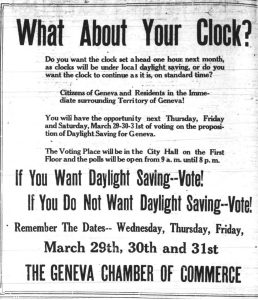100 Years Ago: Daylight Savings
By Becky Chapin, Archivist
Germany was the first to pass a daylight savings law in 1916 to conserve fuel during World War I, and Europe followed soon after. In the United States, a daylight-saving time was adopted on March 19, 1918 through the Standard Time Act of 1918 for the same reason. It was highly unpopular with farmers who had less time in the morning to get their products to market. The act itself was a means to formally legalize standardized time across the country with daylight savings to be in effect for one year only, with that portion of the act to be repealed in August 1919.[i]
In New York State, a movement to make daylight savings permanent was opposed vehemently by farmers in both Ontario and Seneca Counties. In fact, in some sections of Ontario, farmers refused to change their clocks in 1918 like the rest of the country did. To add more confusion, railroads refused to adopt daylight savings time, remaining on standard time throughout the country.
In post-war 1919, daylight savings was repealed by Congress, overriding President Woodrow Wilson’s veto to maintain it. Instead, states were given the option of adopting daylight savings locally. New York State held hearings in March 1920 on possibly repealing the state law providing for daylight savings where several hundred organized Grangers gathered to speak out for the repeal.
Grange leaders maintained that the daylight savings law added 10% to the cost of operating a farm, and many farmers threatened to only produce enough food to feed their own families. Senator Mullan called it “purely camouflage. We simply try to fool ourselves into believing we have an extra hour after work.” The Geneva Daily Times made a good point when it wrote there was nothing preventing manufacturers from starting their work day an hour early on their own.
While the NYS Senate passed the repeal, the Assembly voted to sustain the bill. Another attempt to repeal in April 1920 passed, but Governor Smith vetoed it in May. The bill would have made it possible to pass local ordinances on a village by city basis to adopt daylight savings. An editorial in the Geneva Daily Times believed this would be the last year for daylight savings anyway, writing “the plan will never be tried out again. It never was a good one anyhow.”

Geneva Daily Times March 25, 1922 advertisement by Geneva Chamber of Commerce to call for voters to make their voices known about daylight saving time.
This prediction proved partially correct, as while there was a lot of debate in February 1921, Governor Miller signed the repeal bill in March 1921. In Geneva, daylight saving was discussed by the Common Council and passed in April 1921. School Superintendent Merrell said it would be too much of a hardship on school children. Some, who were already permitted to come in late, relied on standard time trolleys to bring them to school and would be coming to school as late as 10:30am. Seneca Castle Grange concurred with this sentiment, pointing out their children would lose more sleep with the daylight savings system.
While some factories were in favor of daylight saving, others that relied on farms were against it. The Geneva Preserving Company relied on farmers to provide products to the company to can, The manager of the company pointed out that while their workers benefited from an extra hour of daylight during the busy canning season, it wasn’t worth the cost to the farmers.
1921 was a confusing year for Genevans who chose to follow daylight savings time in an area where other villages did not. Local churches offered their services at standard time, following other churches nationwide who said daylight savings subverted sun time, or “God’s time.”[ii] In his January 1922 message, Mayor Catchpole called the “operation of this ordinance…an injustice to our neighbors” since surrounding communities and merchants of Geneva opposed it.
The Geneva Chamber of Commerce decided to hold an informal referendum on the topic of daylight savings. In March 1922, voters from the city of Geneva and surrounding areas voted 2,530 against daylight savings with 689 for it. As a result of the huge turnout, the Common Council voted 9 to 3 to repeal daylight savings in April 1922.
Unfortunately for Geneva and its neighbors, New York City remained solid followers of daylight savings. As a result, year after year more cities began to pass ordinances to do the same. While the agricultural industry continued to oppose it, feelings towards daylight savings in other industries changed 18 years later as the nation found itself watching the outbreak of World War II.
In 1939, the Common Council passed an ordinance to follow daylight saving time and there was more of a mixed reaction than previously; Miss Flannigan was delighted with the extra hour of golf time, while W. Erle Rogers didn’t like not knowing who followed daylight savings or not when he traveled. Local train schedules were printed with the new times to accommodate the changes. Alderman Irnea J Mulvey, an official of Geneva Preserving, said that their farmers were still bringing produce on standard time.
Congress passed the War Time Act in 1942, which expired in 1945, but daylight saving time was reestablished with the Uniform Time Act of 1966. Meanwhile, Geneva adopted daylight saving time officially in 1946, and as one headline put it “Every Man for Himself.”
To finish, I’ll quote Last Week Tonight with John Oliver, Daylight Savings Time: How is This Still a Thing?
[i] https://www.thecongressproject.com/standard-time-act-of-1918
[ii] https://www.smithsonianmag.com/history/100-years-later-madness-daylight-saving-time-endures-180968435/
